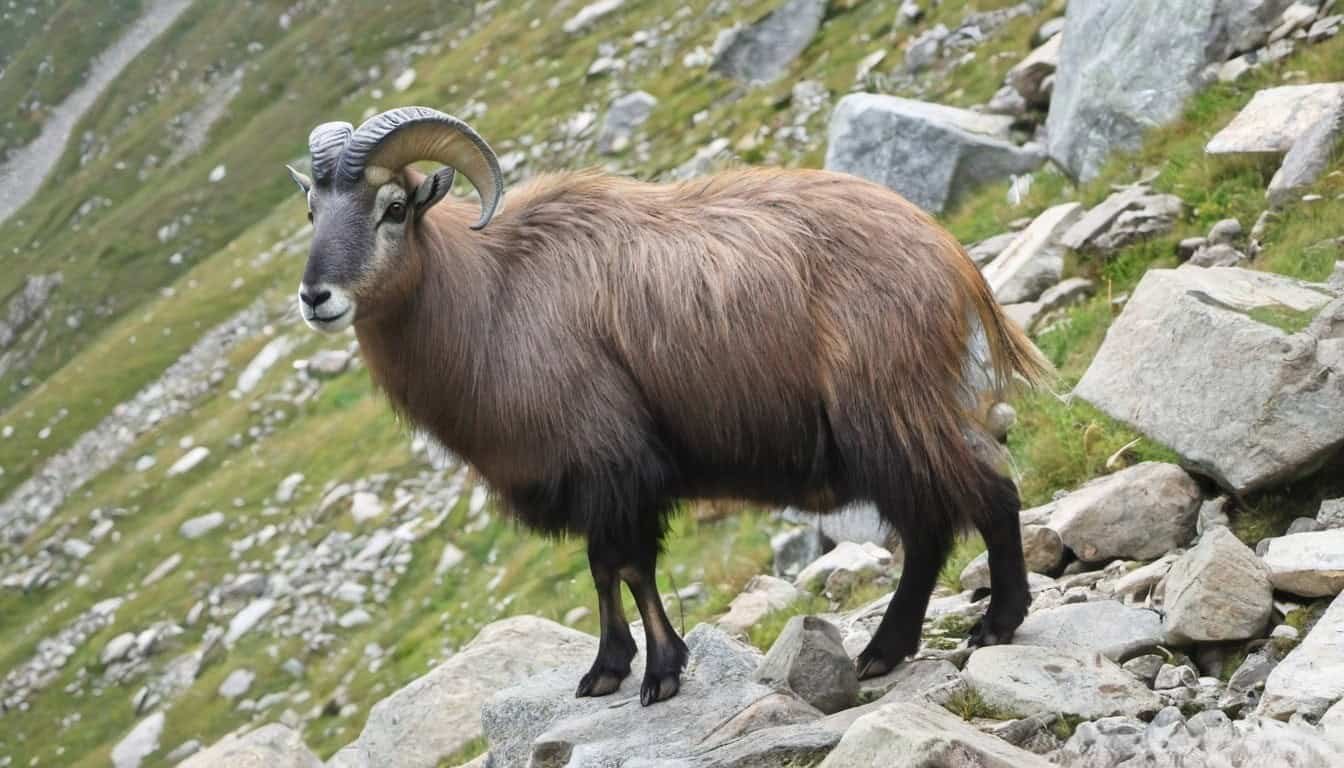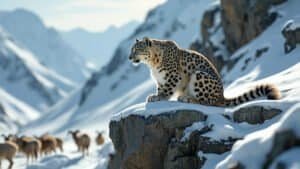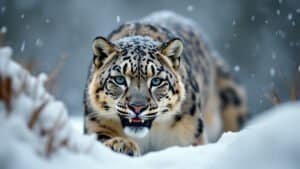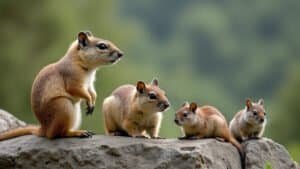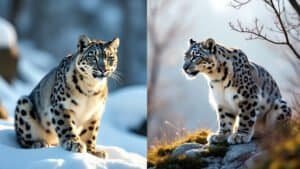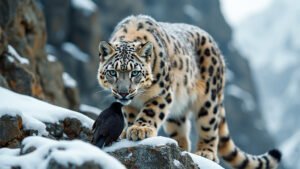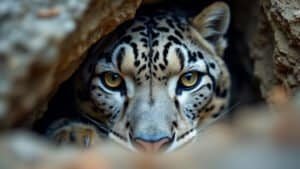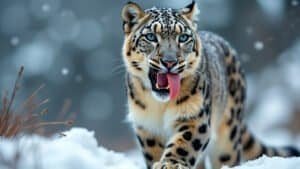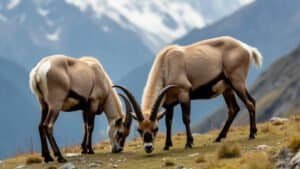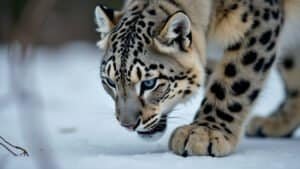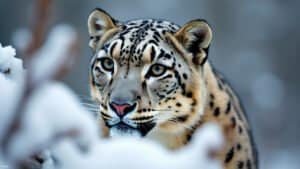Introduction
Snow leopards, known for their elusive nature and majestic presence, primarily inhabit the mountainous regions of Central and South Asia. Understanding their diet is crucial for conservation efforts, as it directly impacts their survival
This article delves into the primary prey species of snow leopards, including ungulates like blue sheep and ibex, and smaller mammals such as marmots and pikas. We will also explore their hunting techniques, the role of domestic animals in their diet, and how prey availability influences snow leopard populations
Lastly, we will discuss ongoing conservation efforts to protect these prey species and ensure the survival of snow leopards
Common Ungulates Hunted By Snow Leopards
Snow leopards primarily prey on various species of ungulates, which are large, hoofed mammals. These ungulates form the bulk of the snow leopard’s diet due to their abundance and significant biomass, providing ample nutrition to sustain the predator
The primary ungulates hunted by snow leopards include blue sheep, ibex, and argali. Each of these species has adapted to the rugged mountainous terrain, making them both challenging and rewarding prey for snow leopards
Blue Sheep
Blue sheep, also known as bharal (Pseudois nayaur), are one of the most common prey species for snow leopards. These medium-sized ungulates are native to the high-altitude regions of the Himalayas, Tibet, and surrounding areas. Blue sheep typically inhabit steep, rocky slopes, which provide them with a strategic advantage against predators
Snow leopards rely on their exceptional climbing skills and stealth to hunt blue sheep
The predator usually stalks its prey, using the rugged terrain for cover, before launching a swift and powerful attack. Blue sheep are social animals, often found in herds, which can include up to several dozen individuals. This social structure can sometimes make it easier for snow leopards to single out and target weaker or younger members of the herd
Ibex
The Siberian ibex (Capra sibirica) is another important prey species for snow leopards. These large, wild goats are found throughout the mountainous regions of Central Asia, including the Himalayas, Altai, and Tien Shan ranges. Ibex are known for their impressive climbing abilities, often navigating steep, rocky cliffs with ease
Snow leopards use their keen senses and patience to hunt ibex. They often observe the ibex from a distance, waiting for an opportunity to strike
When the moment is right, the snow leopard will make a swift and calculated move, relying on surprise and agility to capture its prey. Despite their formidable climbing skills, ibex are not always able to evade the stealthy and powerful snow leopard
Argali
Argali (Ovis ammon) are the largest species of wild sheep and another key prey item for snow leopards
These impressive animals are found in the mountainous regions of Central Asia, including Mongolia, Kazakhstan, and the Himalayas. Argali have adapted to living in high-altitude environments, where they graze on grasses and other vegetation
Hunting argali presents a significant challenge for snow leopards due to the size and strength of these animals. However, snow leopards are adept hunters and use their superior camouflage and stalking abilities to approach their prey undetected. They typically target younger or weaker argali, as these individuals are less capable of defending themselves or escaping a predator
Importance of Ungulates in Snow Leopard Diet
Ungulates are crucial to the diet of snow leopards, providing the necessary energy and nutrients for their survival in harsh environments. The availability of these prey species directly influences the health and reproductive success of snow leopard populations
In regions where ungulate populations are healthy and abundant, snow leopards are more likely to thrive. Conversely, in areas where ungulate numbers are declining due to habitat loss, poaching, or other factors, snow leopards may struggle to find enough food, leading to increased conflict with humans as they turn to livestock for sustenance
Hunting Techniques In Mountainous Terrains
Snow leopards are masterful hunters, uniquely adapted to the harsh and rugged environments of the mountainous regions they inhabit
Their hunting techniques are a blend of patience, stealth, and power, allowing them to effectively capture prey that is often agile and well-adapted to the same terrain. Here, we explore the primary hunting techniques snow leopards use to survive and thrive in their challenging habitats
Stalking and Ambushing
One of the most effective hunting strategies employed by snow leopards is stalking and ambushing. Snow leopards use their excellent camouflage, blending seamlessly with the rocky, snowy landscapes, to get close to their prey undetected
They often position themselves above their target on a rocky outcrop, where they can observe and plan their attack. The combination of their thick, spotted fur and natural stealth makes them nearly invisible to their prey until the moment they strike
Snow leopards are known for their incredible patience, sometimes waiting for hours for the perfect opportunity to launch an ambush. When the moment arrives, they use their powerful hind legs to pounce on their prey, aiming to deliver a swift and fatal bite to the neck. This technique minimizes the risk of a prolonged struggle, which could attract other predators or alert nearby prey
Adaptations for Stealth
Several physical adaptations enable snow leopards to move silently and remain concealed while hunting
Their large, furry paws act like natural snowshoes, distributing their weight evenly and allowing them to walk quietly on snow and rocky surfaces. This adaptation not only aids in their stealth but also provides excellent traction on slippery terrain
Additionally, snow leopards have exceptionally long tails, which they use for balance while navigating steep and uneven ground. Their tails also serve as a counterbalance when making sharp turns during a chase. The fur on their tails is thick and bushy, providing warmth and an extra means of camouflage when curled around their bodies while resting or waiting to ambush prey
Chase and Capture Methods
When stalking and ambushing are not feasible, snow leopards resort to direct chases to capture their prey
These chases, however, are usually short bursts of speed rather than prolonged pursuits, as snow leopards are built for power rather than endurance. They can reach speeds of up to 40 miles per hour in short sprints, using their muscular legs to leap over obstacles and cover ground quickly
During a chase, snow leopards rely on their agility to navigate the rugged terrain, making sharp turns and quick maneuvers to keep up with their prey. They often target the hindquarters of their prey, aiming to knock it off balance or bring it down with a powerful swipe of their forelimbs. Once the prey is down, the snow leopard delivers a killing bite to the neck, ensuring a quick and efficient kill
Environmental Challenges
The mountainous habitats of snow leopards present unique challenges that require specialized hunting techniques. Harsh weather conditions, including heavy snowfall and extreme cold, can make hunting more difficult and physically demanding. The thin air at high altitudes also means that snow leopards must conserve energy and hunt efficiently to survive
Seasonal changes can significantly impact the availability of prey. During winter, many ungulates move to lower altitudes in search of food, forcing snow leopards to travel longer distances to find their next meal. Conversely, in the summer, prey may be more dispersed and harder to locate, requiring snow leopards to cover larger territories to sustain themselves
Smaller Mammals In The Snow Leopard’s Diet
While ungulates are the primary prey for snow leopards, smaller mammals also play a crucial role in their diet, especially when larger prey is scarce
Snow leopards exhibit remarkable adaptability in their hunting strategies and diet composition, which allows them to survive in the varied and often harsh environments of their high-altitude habitats. This section explores the smaller mammals that form an essential part of the snow leopard’s diet
Marmots
Marmots are one of the most common small mammals preyed upon by snow leopards
These large, burrowing rodents are found in alpine and subalpine regions, living in colonies that make them accessible targets. Marmots are relatively slow-moving compared to other prey, making them easier to catch
Snow leopards employ stealth and patience to hunt marmots, often stalking them to their burrows. Marmots spend considerable time foraging above ground during warmer months, providing ample opportunities for snow leopards to strike
The hunting process involves the leopard slowly approaching the marmot, using the terrain for cover, and then quickly pouncing to capture it before it can retreat to its burrow
Pikas
Pikas, small herbivorous mammals related to rabbits, are another important component of the snow leopard’s diet. These small mammals are typically found in rocky mountainous regions where they make their homes in crevices and under rocks
Pikas are highly active during the day, collecting vegetation to store for winter, which makes them vulnerable to predators like snow leopards
Hunting pikas requires a different strategy compared to larger prey. Snow leopards must rely on their sharp eyesight and keen sense of hearing to locate these small, quick animals. Once a pika is spotted, the leopard must act swiftly, using a combination of speed and precision to catch it before it can escape into its rocky hideout
Hares
Hares, including various species adapted to high-altitude environments, also form part of the snow leopard’s diet. These fast and agile animals require snow leopards to use a blend of stealth and speed for a successful hunt. Hares are more challenging to catch due to their speed and acute senses, which make them alert to potential threats
Snow leopards often hunt hares by patiently stalking them and then launching a sudden chase. The leopard’s powerful legs and agility allow it to navigate the terrain effectively, making quick turns and leaps to match the hare’s evasive maneuvers. A successful capture requires the snow leopard to be both faster and more strategic than its prey
Importance of Smaller Mammals in Diet
Smaller mammals like marmots, pikas, and hares are crucial for snow leopards, especially during periods when larger prey is scarce. These smaller prey species provide a reliable food source that helps sustain snow leopards through challenging seasons
The availability of smaller mammals can significantly influence the health and reproductive success of snow leopards, as a consistent food supply ensures they have the necessary energy for hunting, mating, and raising cubs
Seasonal and Environmental Influences
The presence of smaller mammals in the snow leopard’s diet can vary with the seasons and environmental conditions. For example, during the summer months, when ungulates may be more dispersed and harder to catch, snow leopards may rely more heavily on smaller mammals
Conversely, in winter, when snow covers the ground and makes it difficult for smaller mammals to forage, snow leopards may focus on finding larger prey that move to lower altitudes
Environmental factors, such as habitat degradation and climate change, can also impact the availability of these smaller prey species. Conservation efforts aimed at preserving the habitats of snow leopards must also consider the protection of these smaller mammals to ensure a balanced and sustainable ecosystem
Impact Of Domestic Animals On Snow Leopard Diet
The relationship between snow leopards and domestic animals is complex and often contentious, as it involves interactions with human communities living in or near snow leopard habitats
As natural prey becomes scarce due to various factors, snow leopards may turn to domestic animals, such as livestock, as an alternative food source. This section explores the impact of domestic animals on the diet of snow leopards and the implications for conservation and human-wildlife conflict
Livestock Predation
Livestock predation by snow leopards is a significant issue in many regions where these predators and human communities coexist
Domestic animals, including sheep, goats, yaks, and cattle, can become targets for snow leopards, especially when wild prey populations are low. This predation is primarily driven by the ease of catching domestic animals compared to wild prey, as livestock are typically less wary and less agile
Snow leopards often hunt livestock at night when the animals are less guarded and more vulnerable. These predation events can result in substantial economic losses for local herders, leading to negative attitudes towards snow leopards and increased instances of retaliatory killings. The conflict between snow leopards and livestock owners presents a significant challenge for conservation efforts
Human-Wildlife Conflict
Human-wildlife conflict is a major consequence of snow leopards preying on domestic animals. When snow leopards kill livestock, herders may respond by attempting to eliminate the perceived threat
This can involve direct killing of snow leopards or poisoning carcasses to prevent further losses. Such actions not only threaten snow leopard populations but also disrupt the ecological balance of the region
Efforts to mitigate human-wildlife conflict often focus on finding sustainable solutions that protect both snow leopards and livestock. These solutions can include improved livestock management practices, such as constructing predator-proof corrals, employing guard dogs, and implementing community-based monitoring programs
Additionally, compensation schemes and insurance programs can help offset the financial losses experienced by herders, reducing the incentive for retaliatory actions
Mitigation Strategies
Several strategies have been developed to mitigate the impact of snow leopard predation on domestic animals and to promote coexistence between snow leopards and human communities
These strategies aim to protect livestock while ensuring the survival of snow leopards in their natural habitats:
Predator-Proof Corrals: Constructing sturdy, predator-proof enclosures for livestock can significantly reduce the risk of predation. These corrals are designed to prevent snow leopards from accessing the animals, especially at night when they are most vulnerable
Guard Dogs: Employing guard dogs to protect livestock herds can deter snow leopards and other predators. These dogs are trained to stay with the herds and alert herders to the presence of predators, allowing for a quick response to potential threats
Community-Based Monitoring: Engaging local communities in monitoring snow leopard populations and their movements can help anticipate and prevent conflicts. By involving herders in conservation efforts, there is greater understanding and support for measures that protect both livestock and snow leopards
Compensation and Insurance Programs: Implementing compensation schemes and insurance programs can help herders recover from livestock losses due to predation. These programs provide financial relief and reduce the motivation for retaliatory killings. They also encourage herders to adopt livestock management practices that minimize the risk of predation
Conservation Incentives: Providing incentives for communities to participate in snow leopard conservation can foster positive attitudes towards these predators. Initiatives such as eco-tourism, where communities benefit economically from the presence of snow leopards, can create a vested interest in their protection
Influence Of Prey Availability On Snow Leopard Populations
The availability of prey is a critical factor influencing snow leopard populations. As apex predators, snow leopards rely heavily on a stable and abundant prey base to sustain their energy needs, support reproduction, and maintain healthy populations
This section examines how prey availability affects snow leopard populations, considering seasonal variations, the impact of climate change, and conservation efforts aimed at ensuring a stable food supply for these elusive cats
Seasonal Variations
Seasonal changes in prey availability significantly impact the hunting success and survival of snow leopards. During different times of the year, the distribution and behavior of prey species can vary, influencing the ease with which snow leopards can find and capture food
Winter
In winter, snow leopards face the challenge of reduced prey availability as many ungulates migrate to lower altitudes to escape the harsh weather and find food
This migration forces snow leopards to follow their prey into different areas, often leading to increased competition with other predators and potential conflicts with humans. Additionally, snow leopards may turn to smaller mammals, such as pikas and marmots, to supplement their diet during these lean months
Summer
During the summer, prey species like blue sheep, ibex, and argali are more dispersed and harder to locate. The increased vegetation and milder weather allow these ungulates to spread out over larger areas, making it more challenging for snow leopards to hunt. Despite this, the warmer months can also bring a temporary abundance of smaller mammals and birds, providing alternative food sources
Impact Of Climate Change
Climate change poses a significant threat to the availability of prey for snow leopards. Changes in temperature and precipitation patterns can alter the distribution and abundance of key prey species, affecting the overall food web dynamics in mountainous ecosystems
Habitat Shifts
As temperatures rise, the habitats of both snow leopards and their prey are shifting to higher altitudes. This upward movement can lead to a reduction in suitable habitats for prey species, resulting in smaller populations and reduced food availability for snow leopards
Additionally, the fragmentation of habitats due to climate change can isolate prey populations, making it harder for snow leopards to find consistent sources of food
Vegetation Changes
Climate change can also affect the availability and quality of vegetation that prey species rely on for sustenance
Changes in plant growth cycles, the introduction of invasive species, and alterations in the timing of seasonal events can all impact the food resources available to ungulates and other prey. Consequently, this can lead to fluctuations in prey populations and impact the overall health of snow leopard populations
Conservation Efforts
Effective conservation efforts are crucial to maintaining a stable prey base for snow leopards and ensuring their long-term survival. These efforts often focus on habitat preservation, prey population management, and community engagement:
Habitat Preservation: Protecting and restoring habitats that support healthy prey populations is essential for snow leopard conservation
This includes creating protected areas, improving habitat connectivity, and managing human activities that degrade these environments. By ensuring that prey species have access to high-quality habitats, conservationists can help maintain stable and abundant food sources for snow leopards
Prey Population Management: Managing prey populations involves monitoring their numbers, health, and distribution
Conservation programs may include measures to prevent overhunting of prey species by humans, implementing sustainable grazing practices to reduce competition with livestock, and protecting critical habitats from degradation. Effective prey population management ensures that snow leopards have a reliable food supply and reduces the likelihood of human-wildlife conflict
Community Engagement: Engaging local communities in conservation efforts is vital for the success of snow leopard protection initiatives
Programs that involve communities in monitoring prey populations, implementing sustainable land-use practices, and participating in conservation activities can foster positive attitudes towards snow leopards and their prey. Additionally, providing economic incentives, such as eco-tourism opportunities, can encourage communities to support conservation efforts
Conclusion
Snow leopards, as apex predators, rely heavily on a diverse and stable prey base to sustain their populations in the harsh and rugged environments of the mountainous regions they inhabit
Their diet primarily includes large ungulates like blue sheep, ibex, and argali, but also encompasses smaller mammals such as marmots, pikas, and hares. The hunting techniques of snow leopards, including stalking, ambushing, and short chases, demonstrate their remarkable adaptability and survival skills
The impact of domestic animals on snow leopard diets highlights the complex relationship between these predators and human communities. Livestock predation can lead to significant human-wildlife conflict, but mitigation strategies like predator-proof corrals, guard dogs, and compensation programs can promote coexistence
Prey availability is a critical factor influencing snow leopard populations, with seasonal variations and climate change posing significant challenges. Conservation efforts focused on habitat preservation, prey population management, and community engagement are essential for maintaining a stable prey base and ensuring the long-term survival of snow leopards
By understanding the intricate dynamics of snow leopard diets and implementing effective conservation strategies, we can support the continued existence of these majestic cats and the ecosystems they inhabit. The preservation of snow leopards and their prey is not only crucial for biodiversity but also for the cultural and ecological integrity of the mountainous regions they call home
